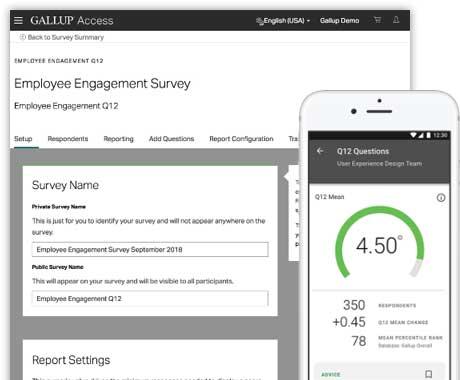Story Highlights
- The benefits of customer centricity are far-reaching
- Ensure employees understand your brand promise
- Take calculated steps to improve customer engagement
Bad customer service in Europe is a cliché in America, and arrogant American customers are a cliché in Europe. The conflicting clichés reflect different cultural outlooks, of course, and neither side is right. It's just a matter of opinion.
But this is a fact: Employees who think their company is customer-centric are very optimistic about their companies and their future.
Indeed, Gallup finds that, of those who strongly agree that "my organization is the perfect organization for our customers," 37% think their company is ahead of the competition, 56% are confident in their company's financial future, and 61% are convinced that their company is successful and growing.
On the other hand, of employees who disagree that their employer is "perfect" for their customers only 4% think they're ahead of the competition, 17% are confident about their company's financial future, and a measly 2% think their company is successful and growing.
Now, consider those different cultural outlooks again. Europeans can roll their eyes about needy, demanding Americans -- not without justification -- but business leaders should remember that fully engaged customers give 23% more share of wallet, Gallup analysis finds, than the average customer.
This is true across societies. That is, all customers want an engaging experience -- and engaged customers are always the most lucrative.
Plus, as COVID-19 cases spike and lockdowns increase, European businesses need every customer they can get. The battle for the marketplace will only intensify when restrictions ease. In that kind of business environment, leaders need to rethink their cultural approach to customer centricity, their brand promise, and their employees' relationship to both.
You can't keep a promise if you don't know what it is.
To some extent, customer expectations are conditioned by the society the customer lives in -- that's why a German probably wouldn't tell a waiter all his food sensitivities so the chef could revise the recipe and an American very well might.
Employees who think their company is customer-centric are very optimistic about their companies and their future.
But to an even greater extent, customer expectations are set by the brand promise. Gallup defines brand promise as a company's unique essence, positioning and value proposition. Unfortunately, only 48% of European employees strongly agree they know what their company stands for and what makes it different from its competitors. Worse, less than a third strongly agree their company "always delivers on the brand promise" (29%) or that their "coworkers always do what is right for our customers" (27%).
That's doubly alarming as most Europeans have customer-facing jobs (69% in France, 68% in Spain, 67% in Germany, 67% in the U.K.) with near-daily customer contact (88% in the U.K., 84% in Spain, 78% in France, 77% in Germany). Hence, most of the people with the greatest responsibly for executing on the brand promise and with the most frequent access to customers don't think they're keeping the brand promise -- or even know what it is.
As a result, those employees are alienated from the brand, the company's purpose and, ultimately, the customer. That gives customers less motivation to engage with the brand. Or to remain customers at all.
Change company culture by changing employees' outlook.
Engaged customers -- or rather, their 23% premium -- are going to be a godsend for struggling European businesses. But to engage customers, leaders will have to focus on them like never before.
Just to be clear, European businesses don't have to Americanize. Nor should they. Only about a quarter of American employees strongly agree that "My organization always delivers on the promise we make to customers" (25%) or that "My organization is the perfect organization for our customers" (27%), and 41% strongly agree, "I know what my organization stands for, and what makes our brand different from our competitors."
That's no better -- and sometimes a lot worse -- than any European country Gallup studied. Fifty-six percent in the U.K., 52% in Germany, 43% in Spain, and 39% in France strongly agree they "know what [their] company stands for, and what makes [it] different from its competitors." Similarly, 33% in the U.K., 30% in France, 28% in Spain, and 18% in Germany strongly agree "my coworkers always do what is right for our customers;" and 34% in Germany, 29% in the U.K., 27% in France, and 26% in Spain strongly agree their company "always delivers on the [brand] promise."
Furthermore, pretending to be something you're not is inauthentic, unsustainable and won't increase customer trust in the brand. But European businesses can centralize customers in their own way, and it starts with changing the way employees relate to customers.
- Market analysis details what customers care about most. Relay that analysis to employees. Few employees strongly agree they "regularly receive information about what is important to our customers" (41% in the U.K., 30% in Germany, 26% in Spain, and 24% in France), but that insight tells customer-facing people how to execute the brand promise better.
- Take customer feedback seriously. Only 29% of employees in the U.K., 25% in France, 23% in Spain, and 20% in Germany strongly agree "comments and suggestions from customers always lead to concrete improvement in our company." But feedback is free market intelligence and sharpens employee performance.
- Consider staffing up as soon as possible. Most employees say there are too few of them to properly serve customers -- only 24% in Europe strongly agree that "in our department, we have enough employees to always take care of our customers" (27% in Spain, 24% in Germany, 23% in France, 22% in the U.K.) -- and customer engagement depends on real connections through interactions with employees.
- Make it easy to exchange information and provide a holistic customer experience. That puts customers at the center of everything instead of at the end of the service chain. Unfortunately, most employees say they're siloed in their companies: 24% in Germany, 23% in the U.K., and 21% in France and Spain strongly agree they're "satisfied with the cooperation between my department and other departments with which I work." And 38% in the U.K., 36% in France, 35% in Germany, and 30% in Spain strongly agree that "in my company, we openly share information, knowledge and ideas with each other."
Those recommendations are process improvements, not really culture-change initiatives. But changing process is a big step toward changing culture. And leaders who explain their intended outcomes -- "Read these market reports because they'll help you understand what customers need," "Come to this project management meeting so you're ready for our product release," "What's the best way to use this customer suggestion?" -- move employees toward a more customer-centric outlook.
That outlook is a culture change in many businesses. But it's not a radical one -- most Europeans have had enough of change as it is -- rather, it's just a way to bring customers into clearer focus. Employees who use that view are better able to deliver on the brand promise, and that's a huge step toward engaging customers.
Customer centricity will not Americanize European businesses. Nor should it. Europeans don't want an American experience in a German shoe store, British insurance agency, a Spanish restaurant or French car dealership. Their expectations conform to their society.
But Europeans do want a customer-centric experience. That's not a culture thing -- that's a human thing, and any European business can deliver it. They'll certainly find willing recipients. Just like Americans, European customers want to engage -- they're just less likely to tell the waiter so.
Take steps now to engage your customers:
- Learn about Gallup's Customer-Centricity Framework.
- Read our perspective paper on how to build a customer-centric culture.
- Register for our webinar The New Era of B2B Growth: Analytics-Based Sales.






